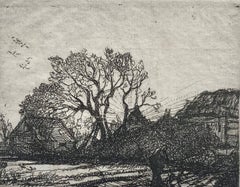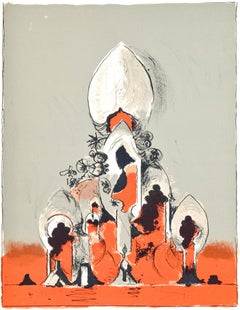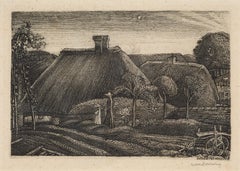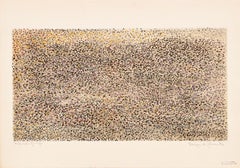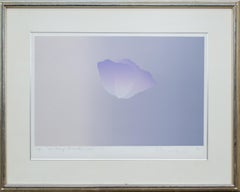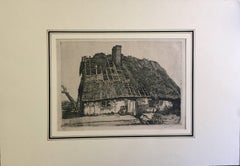Graham Sutherland Landscape Prints
British, 1903-1870
Graham Sutherland OM was a prolific English artist. Notable for his paintings of abstract landscapes and for his portraits of public figures, Sutherland also worked in other media, including printmaking, tapestry, and glass design.
Printmaking, mostly of romantic landscapes, dominated Sutherland's work during the 1920s. He developed his art by working in watercolors before switching to using oil paints in the 1940s. A series of surreal oil paintings depicting the Pembrokeshire landscape secured his reputation as a leading British modern artist.to
2
4
Overall Width
to
Overall Height
to
2
59
189
169
156
146
4
2
1
3
1
2
2
2
2
2
2
1
1
3
1
2
2
2
Artist: Graham Sutherland
Cudham, Kent
By Graham Sutherland
Located in Storrs, CT
Cudham, Kent. 1924. Etching. Tassi 15; Cooke 20. 3 1/8 x 4 (sheet 4 3/8 x 6 7/16). Edition of 42, including some artist's proofs. Published by the Twenty-One Gallery in London. Slight paper loss in the top left-hand corner. A rich impression with plate tone, printed by the artist on antique laid paper...
Category
Early 20th Century Modern Graham Sutherland Landscape Prints
Materials
Etching
$2,800 Sale Price
20% Off
Graham Sutherland, The Cathedral I, from San Lazzaro et ses Amis, 1975
By Graham Sutherland
Located in Southampton, NY
This exquisite lithograph by Graham Sutherland (1903–1980), titled The Cathedral I, from the album San Lazzaro et ses Amis, Hommage au fondateur de la revue XXe siecle (San Lazzaro a...
Category
1970s Modern Graham Sutherland Landscape Prints
Materials
Lithograph
Pecken Wood, 1925 - Rural Landscape Etching, with Farming, Trees and Countryside
By Graham Sutherland
Located in Kingsclere, GB
Graham Sutherland was a painter of imaginative landscapes, still life, figure pieces and portraits.
He was born on 24 August 1903 in London. He abandoned a railway engineering apprenticeship after a year and studied at Goldsmiths' College School of Art, where he specialized in engraving and etching. Sutherland's formative influences on his early work were Blake, Samuel Palmer, the late Turner, Paul Nash and Henry Moore. He held his first and second exhibitions of drawings and engravings at the XXI Gallery, London, in 1925 and 1928. and was a member of the Royal Society of Painter-Etchers and Engravers from 1926-33.
Sutherland taught engraving at the Chelsea School of Art from December 1926 and composition and book illustration 1935 to July 1940. He exhibited at the N.E.A.C. 1929-33 and with the London Group from 1932 (member 1936-7), experimenting with painting in oils from 1930 until, in 1935, the year after his first visit to Pembrokeshire, he decided to become a painter. He participated in the International Surrealist Exhibition in London 1936 and had his first one-man exhibition of oil paintings, mainly Welsh landscapes, at the Paul Rosenberg and Helft Gallery 1938.
As an Official War Artist 1941-4 he painted scenes of bomb devastation and of work in mines and foundries. Sutherland's first New York exhibition was at the Buchholz Gallery 1946, and in the same year he completed the 'Crucifixion' for St Matthew's Church, Northampton. He taught painting at Goldsmiths' College as a visiting instructor and since 1947 worked for several months each year on the French Riviera. He was a trustee of the Tate Gallery 1948-54. Painted the portrait of Somerset Maugham 1949, the first of a series which includes Lord Beaverbrook, Sir Winston Churchill and others. He completed the designs for the Coventry Cathedral tapestry, 'Christ in Glory in the Tetramorph', between 1954 and 1957 (installed 1962). Has also designed posters, ceramics, book illustrations, and ballet costumes and décor for The Wanderer 1940. Important retrospective exhibitions have been held at the I.C.A. 1951, the Venice Biennale and the Musée National d'Art Moderne, Paris, 1952, the Tate Gallery 1953, and at the São Paulo Bienal, Brazil, 1955. Awarded the O.M. 1960.
Collections include the Courtauld, London, and that of David Bow
Category
1920s Graham Sutherland Landscape Prints
Materials
Etching
Lammas, 1926 - Rural Landscape Etching, with Trees, House, Gardens and Figures
By Graham Sutherland
Located in Kingsclere, GB
Graham Sutherland was a painter of imaginative landscapes, still life, figure pieces and portraits.
He was born on 24 August 1903 in London. He abandoned a railway engineering app...
Category
1920s Graham Sutherland Landscape Prints
Materials
Etching
Related Items
Beach Horizontal
By Manfred Schwartz
Located in Astoria, NY
Manfred Schwartz (American, b. Poland, 1909-1970), Beach Horizontal Composition, Lithograph on Paper, mid 20th century, marked "artist's proof" lower left, signed in pencil and with ...
Category
Mid-20th Century Modern Graham Sutherland Landscape Prints
Materials
Paper, Lithograph
Three Lovely Kozo Inoue Pastel Prints, 1980s
By Kozo Inoue
Located in New York, NY
Kozo Inoue (Japanese, 1937-2017)
Untitled, 1980
Lithograph
Sight: 22 x 31 in. (Each)
Framed: 34 x 42 1/2 x 1 in. (Each)
Signed and dated 1980 lower right
Inscribed lower left
Kozo Inoue was a contemporary Japanese printmaker. Born in Osaka, he graduated from the Department of Art History at Keio University in 1960. During life, he worked during the winter months in the Izu Peninsula and Dordogne or Paris in the summer. He is known for his surrealistic silkscreen prints. His prints can be found in the Museum of Modern Art, Paris, Royal Library of Belgium, Modern Museum of Art Osaka and the Spencer Museum of Art, to name just a few. (Bio sourced from Ronin Gallery)
Category
1980s Modern Graham Sutherland Landscape Prints
Materials
Lithograph
Irving Guyer, Roll Them Bones, Depression-era African-American men at craps
By Irving Guyer
Located in New York, NY
An American Depression-Era subject of African-American men playing craps by Irving Guyer.. (Craps is a game of chance that required neither skill nor strategy. The object is to predi...
Category
1930s Ashcan School Graham Sutherland Landscape Prints
Materials
Etching
Rapunzel, Rapunzel, let down your hair David Hockney Brothers Grimm Fairy Tales
By David Hockney
Located in New York, NY
From David Hockney’s celebrated Six Fairy Tales from the Brothers Grimm portfolio, an image from the story of Rapunzel, which he chose for its popularity. When illustrating the princ...
Category
1960s Modern Graham Sutherland Landscape Prints
Materials
Etching, Aquatint
The Cavern: abstract black drawing based on Auden poetry and Yorkshire landscape
By Henry Moore
Located in New York, NY
One of a series of 18 lithographs drawn by the artist for the Auden Poems/Moore Lithographs 1974 book and portfolio. This work is from an edition of 25 printed on vellum aside from t...
Category
Late 20th Century Modern Graham Sutherland Landscape Prints
Materials
Lithograph
$1,200
H 25.25 in W 20.5 in
Italian Summer, Framed Etching by Michael Chapman
By Michael James Chaplin
Located in Brecon, Powys
Etching from the studio of this acclaimed British Watercolorist.
Good condition. Image 15.5" x 11.5"
English artist Michael Chaplin is a Member of the Royal Watercolor Society, pa...
Category
1990s Realist Graham Sutherland Landscape Prints
Materials
Etching
Pool Patterns, Nautical Abstract Seascape Triptych, Blue Cyanotype Print
By Kind of Cyan
Located in Barcelona, ES
This is an exclusive handprinted limited edition of a cyanotype.
This beautiful triptych is called "Fresh California Pool patterns", which shows the semi-abstract movements of light reflecting in a California swimming pool.
Details:
+ Edition Size: only 20
+ Medium: Cyanotype Print on Watercolor Paper
+ Stamped and Certificate of Authenticity provided.
+ Measurements : 100x210 cm (40 x 84 in.)
Each paper measures 100cm x 70cm (about 40 in. x 28 in.) each. , a standard frame size.
+ All cyanotype prints...
Category
2010s Modern Graham Sutherland Landscape Prints
Materials
Lithograph
Salvador Dalí, "Le Chateau de Gala", original etching, hand colored, signed
By Salvador Dalí
Located in Chatsworth, CA
Salvador Dalí
Le Chateau de Gala (Gala's Castle) from After 50 Years of Surrealism
Original etching, hand colored
1974
Image size: 15 3/...
Category
1970s Modern Graham Sutherland Landscape Prints
Materials
Etching
$4,400 Sale Price
44% Off
H 26 in W 19.75 in
India Figurative Landscape 1910 Buddha Rare Early Original Etching
Located in Norfolk, GB
Ernest Stephen Lumsden RE, RSA
Ernest Stephen Lumsden RE, RSA
(1883 – 1948)
Buddha
Frame Size: 40.7cm x 52.5cm
Image: 21cm x 34 cm
Lumsden reference: 254
Edition 33/50
Whatman w...
Category
1910s Other Art Style Graham Sutherland Landscape Prints
Materials
Paper, Etching
$1,339
H 16.03 in W 20.67 in D 0.4 in
The glass mountain shattered David Hockney Fairy Tales from the Brothers Grimm
By David Hockney
Located in New York, NY
This etching from David Hockney’s celebrated Six Fairy Tales from the Brothers Grimm portfolio depicts the somewhat obscure story Old Rinkrank, which Hockney chose to illustrate beca...
Category
1960s Modern Graham Sutherland Landscape Prints
Materials
Etching, Aquatint
New York City Skyline Modern Print Chrysler State Building Framed Unique Etching
By Katherine Gallagher
Located in Buffalo, NY
Limited edition aquatint etching of the New York City skyline by Katherine E. Gallagher. This piece features the famous Chrysler Building prominently in the background along with a M...
Category
1980s Realist Graham Sutherland Landscape Prints
Materials
Etching, Aquatint
$951 Sale Price
20% Off
H 32 in W 27 in D 1 in
Ancient Roman Architecture: Original Framed 18th C. Etching by G. Piranesi
By Giovanni Battista Piranesi
Located in Alamo, CA
"Veduta del Sepolcro della Famiglia Plauzia per la Strada Che Conduce da Roma a Tivoli vicino a Ponte Lugano" from "Le Antichità Romane" (Roman Antiquities), one of the most famous works by Piranesi. "Antichita" illustrates the tombs along the Appian Way...
Category
Early 18th Century Old Masters Graham Sutherland Landscape Prints
Materials
Etching, Engraving, Drypoint
$3,100 Sale Price
20% Off
H 24.38 in W 31.75 in D 0.75 in
Previously Available Items
Number Forty-Nine
By Graham Sutherland
Located in Roma, IT
Hand signed. Edition of 60 prints.
Image dimensions : 17 x 25 cm
Category
1920s Modern Graham Sutherland Landscape Prints
Materials
Etching
Graham Sutherland landscape prints for sale on 1stDibs.
Find a wide variety of authentic Graham Sutherland landscape prints available for sale on 1stDibs. You can also browse by medium to find art by Graham Sutherland in etching and more. Much of the original work by this artist or collective was created during the 20th century and is mostly associated with the modern style. Not every interior allows for large Graham Sutherland landscape prints, so small editions measuring 4 inches across are available. Customers who are interested in this artist might also find the work of Edmund Blampied, James McBey., and Arthur John Trevor Briscoe. Graham Sutherland landscape prints prices can differ depending upon medium, time period and other attributes. On 1stDibs, the price for these items starts at $2,800 and tops out at $3,750, while the average work can sell for $3,275.
Artists Similar to Graham Sutherland
Questions About Graham Sutherland Landscape Prints
- 1stDibs ExpertApril 5, 2022Graham Sutherland studied art at Epsom College in London and also taught printmaking at the Chelsea School of Art. Sutherland is a painter best known for his Surrealistic landscapes. Find a variety of Graham Sutherland art from some of the world’s top dealers on 1stDibs.
- 1stDibs ExpertSeptember 16, 2024How much Graham Sutherland paintings are worth depends on their size, historical significance, condition and other factors. In 2011, The Crucifixion set a record for the artist's work, selling for more than $1.1 million at auction. Sutherland was a prolific English artist. Notable for his paintings of abstract landscapes and for his portraits of public figures, he also worked in other media, including printmaking, tapestry and glass design. To get a valuation for a particular piece by the British artist, enlist the help of a certified appraiser or knowledgeable art dealer. On 1stDibs, find a diverse assortment of Graham Sutherland art.
